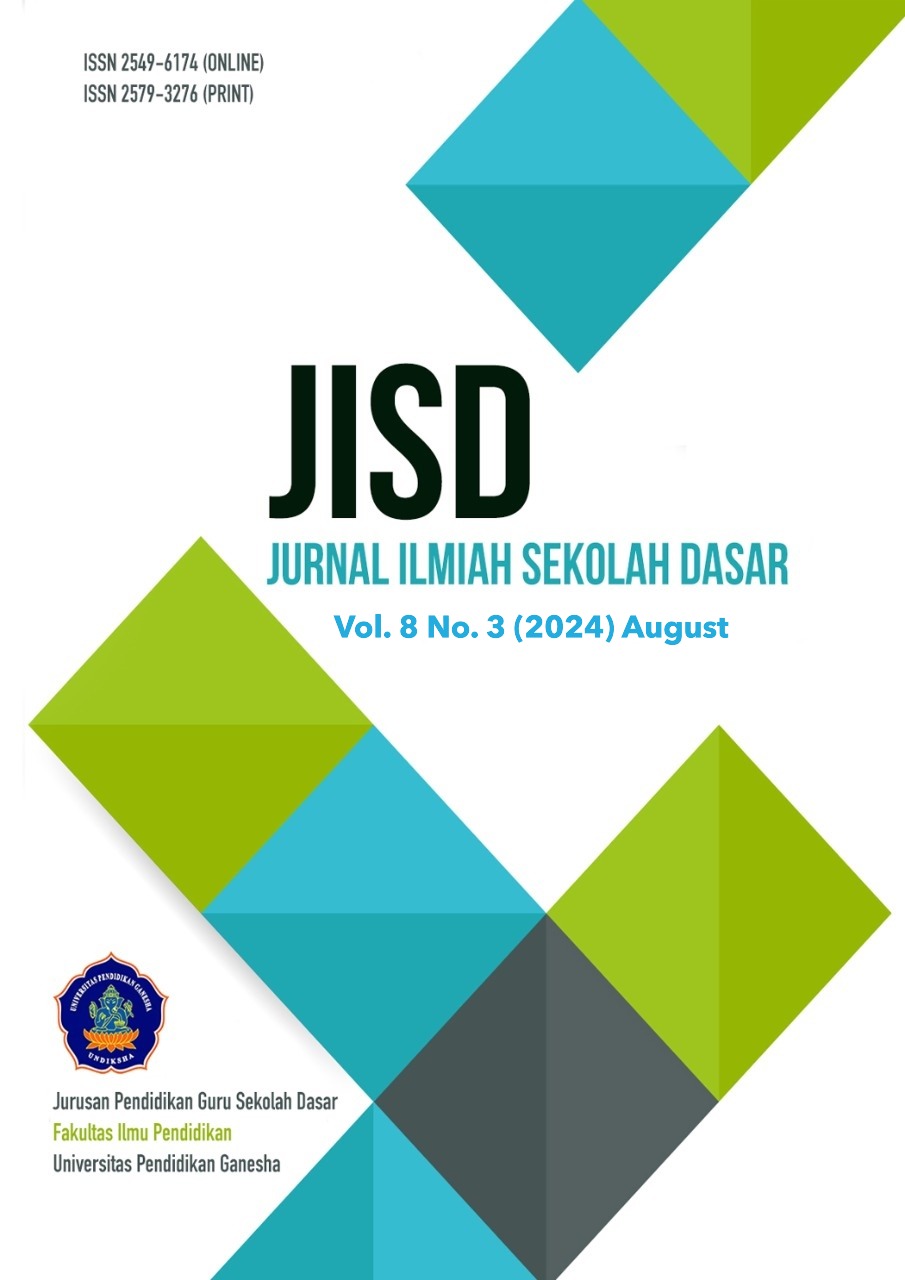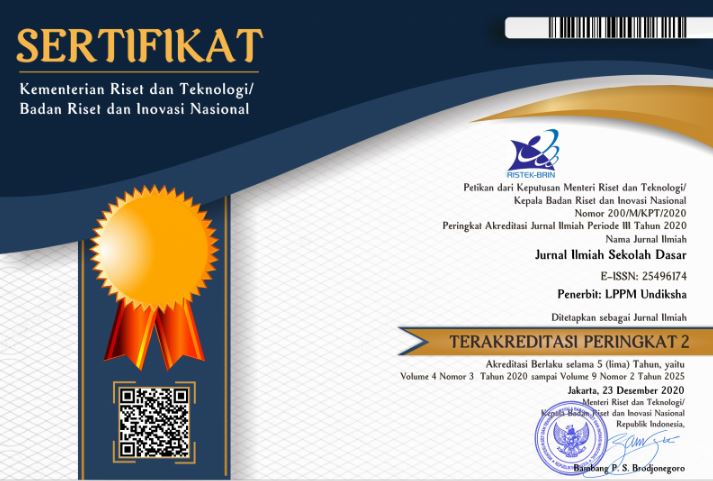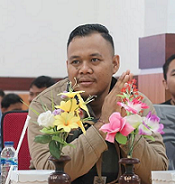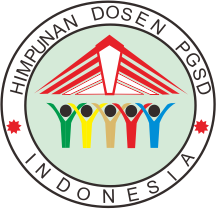Measuring Learning Outcomes of Integer Arithmetic Operations through E-MoBil Media in Primary Education
DOI:
https://doi.org/10.23887/jisd.v8i3.69714Keywords:
Learning Outcomes Scale, Confirmatory Factor Analysis, Learning MediaAbstract
The ability of Indonesian students to solve math exam questions, particularly in integer arithmetic operations, remains a challenge, indicating incomplete mastery of mathematical concepts. This study aims to test the construct validity and reliability of a learning outcome scale for integer arithmetic operations in AKM numeracy for fifth-grade elementary school students through the development of E-MoBil media based on Flip PDF Professional. The development method used follows Borg & Gall's model but focuses on nine key steps: information gathering, planning, initial product development, preliminary field testing, initial product revision, main field testing, product revision, operational field testing, and final product revision. The primary data collection instrument was a questionnaire, analyzed using confirmatory factor analysis with LISREL 8.80 software. The results show that the developed learning outcome scale meets the criteria for model fit, convergent validity, discriminant validity, and construct reliability. These findings demonstrate that the E-MoBil media developed using Flip PDF Professional is effective in enhancing students' understanding of integer arithmetic operations and is suitable for use in learning activities. This study provides significant contributions to the development of technology-based learning evaluation tools to improve elementary students' numeracy literacy.
References
Abrahamson, D., Nathan, M. J., Williams-Pierce, C., Walkington, C., Ottmar, E. R., Soto, H., & Alibali, M. W. (2020). The Future of Embodied Design for Mathematics Teaching and Learning. Frontiers in Education, 5. https://doi.org/10.3389/feduc.2020.00147.
Aguirre, M. G. (2013). Dynamic Capabilities and Competitive Advantage into Mexican Firms: Testing Gibrat´s Law. Revista Nicolaita de Estudios Económicos, 6(2), 35–56.
https://doi.org/10.33110/rnee.v6i2.135.
Ahdhianto, E., Marsigit, Haryanto, & Nurfauzi, Y. (2020). Improving Fifth-Grade Students’ Mathematical Problem-solving and Critical Thinking Skills Using Problem-Based Learning. Universal Journal of Educational Research, 8(5), 2012–2021. https://doi.org/10.13189/ujer.2020.080539.
Aka, K. A. (2019). Integration Borg & Gall (1983) and Lee & Owen (2004) models as an alternative model of design-based research of interactive multimedia in elementary school. Journal of Physics: Conference Series, 1318(1). https://doi.org/10.1088/1742-6596/1318/1/012022.
Aliyah, A. A., & Purwanto, S. E. (2022). Pengaruh Media Pembelajaran Powtoon Terhadap hasil Belajar Matematika Pada Materi Perkalian Siswa Kelas II Sekolah Dasar. Jurnal Ideas: Pendidikan, Sosial, Dan Budaya, Vol. 8 No. https://doi.org/10.32884/ideas.v8i3.946.
Andiani, D., Hajizah, M. N., & Dahlan, J. A. (2021). Analisis rancangan assesmen kompetensi minimum (AKM) numerasi program merdeka belajar. Majamath: Jurnal Matematika Dan Pendidikan Matematika, 4(1), 80–90. https://doi.org/10.31004/basicedu.v6i3.2907.
Asria, L., Sari, D. R., Ngaini, S. A., Muyasaroh, U., & Rahmawati, F. (2021). Analisis Antusiasme Siswa Dalam Evaluasi Belajar Menggunakan Platform Quizizz. Alifmatika: Jurnal Pendidikan Dan Pembelajaran Matematika, 3(1), 1–17. https://doi.org/10.35316/alifmatika.2021.v3i1.1-17.
Auerswald, M., & Moshagen, M. (2019). How to determine the number of factors to retain in exploratory factor analysis: A comparison of extraction methods under realistic conditions. Psychological Methods, 24(4), 468–491. https://doi.org/10.1037/met0000200.
Azzahra, M., & Nurrohmatul Amaliyah. (2022). Analisis Faktor Penyebab Kesulitan Siswa Dalam Pembelajaran Tematik Di Kelas Iv Sekolah Dasar. Jurnal Cakrawala Pendas, 8(3), 851–859. https://doi.org/10.31949/jcp.v8i3.2677.
Bragg, L. A., Walsh, C., & Heyeres, M. (2021). Successful design and delivery of online professional development for teachers: A systematic review of the literature. Computers & Education, 166, 104158. https://doi.org/10.1016/j.compedu.2021.104158.
Brown, A. M., Lewis, S. N., & Bevan, D. R. (2016). Development of a structured undergraduate research experience: Framework and implications. Biochemistry and Molecular Biology Education, 44(5), 463–474. https://doi.org/10.1002/bmb.20975.
Bryan, C., & Clegg, K. (2019). Innovative Assessment in Higher Education (C. Bryan & K. Clegg (eds.)). Routledge. https://doi.org/10.4324/9780429506857.
Bybee, R., & McCrae, B. (2011). Scientific literacy and student attitudes: Perspectives from pisa 2006 science. International Journal of Science Education, 33(1).
https://doi.org/10.1080/09500693.2010.518644.
Cai, J., & Hwang, S. (2021). Teachers as redesigners of curriculum to teach mathematics through problem posing: conceptualization and initial findings of a problem‑posing project. ZDM – Mathematics Education, 53(6), 1403–1416. https://doi.org/10.1007/s11858-021-01252-3.
Clark, L. A., & Watson, D. (2019). Constructing Validity: New Developments in Creating Objective Measuring Instruments. Psychological Assessment, 176(3), 1412.
https://doi.org/10.1037/pas0000626.Constructing.
Comrey, A. L., & Lee, H. B. (2013). A First Course in Factor Analysis. Psychology Press. https://doi.org/10.4324/9781315827506.
Deng, L., Wu, S., Chen, Y., & Peng, Z. (2020). Digital game‐based learning in a Shanghai primary‐school mathematics class: A case study. Journal of Computer Assisted Learning, 36(5), 709–717. https://doi.org/10.1111/jcal.12438.
Diantoro, F., Purwati, E., & Lisdiawati, E. (2021). Upaya Pencapaian Tujuan Pendidikan Islam Dalam Pendidikan Nasional Dimasa Pandemi Covid-19. MA’ALIM: Jurnal Pendidikan Islam, 2(01). https://doi.org/10.21154/maalim.v2i01.3035.
Engelbrecht, J., Llinares, S., & Borba, M. C. (2020). Transformation of the mathematics classroom with the internet. ZDM - Mathematics Education, 52(5), 825–841. https://doi.org/10.1007/s11858-020-01176-4.
Farhadiba, D., & Nunuk Wulyani, A. (2020). Investigating Preservice Teachers’ Efficacy Level and Factors Influencing It. KnE Social Sciences, 2020, 40–49. https://doi.org/10.18502/kss.v4i4.6464.
Genc, M., & Erbas, A. (2019). Secondary Mathematics Teachers’ Conceptions of Mathematical Literacy. International Journal of Education in Mathematics Science and Technology, 7, 222–237. https://ijemst.org/index.php/ijemst/article/view/611.
Gersten, R., Beckmann, S., Clarke, B., Foegen, A., Marsh, L., Star, J. R., & Witzel, B. (2009). Assisting Students Struggling with Mathematics:Response to Intervention (RtI) for elementary and middle schools. What Works Clearinghouse, 1–98.
Gilligan, K. A., Hodgkiss, A., Thomas, M. S. C., & Farran, E. K. (2019). The developmental relations between spatial cognition and mathematics in primary school children. Developmental Science, 22(4). https://doi.org/10.1111/desc.12786.
Goretzko, D., Pham, T. T. H., & Bühner, M. (2021). Exploratory factor analysis: Current use, methodological developments and recommendations for good practice. Current Psychology, 40(7), 3510–3521. https://doi.org/10.1007/s12144-019-00300-2.
Griffith, M. D. (2016). Review of A Step-by-Step Approach to Using SAS for Factor Analysis and Structural Equation Modeling (2nd ed.) , by Norm O’Rourke and Larry Hatcher. Structural Equation Modeling: A Multidisciplinary Journal, 23(1), 157–161. https://doi.org/10.1080/10705511.2015.1026596.
Guillén-Gámez, F. D., Ruiz-Palmero, J., & García, M. G. (2023). Digital competence of teachers in the use of ICT for research work: development of an instrument from a PLS-SEM approach. Education and Information Technologies, 28(12), 16509–16529. https://doi.org/10.1007/s10639-023-11895-2.
Hermanto, B. (2020). Perekayasaan sistem pendidikan nasional untuk mencerdaskan kehidupan bangsa. FOUNDASIA, 11(2). https://doi.org/10.21831/foundasia.v11i2.26933.
Hidayat, E. I. F., Vivi Yandhari, I. A., & Alamsyah, T. P. (2020). Efektivitas Pendekatan Realistic Mathematics Education (RME) Untuk Meningkatkan Kemampuan Pemahaman Konsep Matematika Siswa Kelas V. Jurnal Ilmiah Sekolah Dasar, 4(1), 106. https://doi.org/10.23887/jisd.v4i1.21103.
Hwang, J., & Ham, Y. (2021). Relationship between mathematical literacy and opportunity to learn with different types of mathematical tasks. Journal on Mathematics Education, 12(2), 199–222. https://doi.org/10.22342/JME.12.2.13625.199-222.
Idoga, P. E., Oluwajana, D. I., & Adeshola, I. (2022). Educational quality and technological complexity on recognition of enhanced learning platform in developing countries using PLS-SEM in a post COVID era. Educational Technology Research and Development, 70(6), 2255–2273.
https://doi.org/10.1007/s11423-022-10150-8.
Ilham, D. (2019). Menggagas Pendidikan Nilai dalam Sistem Pendidikan Nasional. Didaktika: Jurnal Kependidikan, 8(3), 109–122. https://doi.org/10.58230/27454312.73.
Karim, A., & Savitri, D. (2020). Pengembangan media pembelajaran matematika berbasis android di kelas 4 sekolah dasar. Jurnal Lebesgue: Jurnal Ilmiah Pendidikan Matematika, Matematika Dan Statistika, 1(2), 63–75. https://doi.org/10.46306/lb.v1i2.17.
Kellems, R. O., Eichelberger, C., Cacciatore, G., Jensen, M., Frazier, B., Simons, K., & Zaru, M. (2020). Using Video-Based Instruction via Augmented Reality to Teach Mathematics to Middle School Students With Learning Disabilities. Journal of Learning Disabilities, 53(4), 277–291.
https://doi.org/10.1177/0022219420906452.
Kurniawan, H. (2021). Pengantar Praktis Penyusunan Instrumen Penelitian. Deepublish.
Liang, D., Lau, N., & Antin, J. (2022). A Structural Equation Model of Older Adults’ Driving Exposure and Avoidance Using Objective Driving Records. Proceedings of the Human Factors and Ergonomics Society Annual Meeting, 66(1), 6–7. https://doi.org/10.1177/1071181322661152.
Liu, Z.-Y., Lomovtseva, N., & Korobeynikova, E. (2020). Online Learning Platforms: Reconstructing Modern Higher Education. International Journal of Emerging Technologies in Learning (IJET), 15(13), 4. https://doi.org/10.3991/ijet.v15i13.14645.
Manik, J., Faizah, N., & Ginting, W. (2023). Pengembangan Aplikasi Game Edukasi Matematika SD 02 Pagi Pondok Labu Berbasis Android dengan Metode Rapid Application Development Menggunakan Adobe Flash CS6. Design Journal, 1(1), 99–108. https://doi.org/10.58477/dj.v1i1.62.
Mardhotillah, N. I., & Yulhendri. (2022). Confirmatory factor analysis (cfa) interaksi dosen-mahasiswa dalam pembelajaran daring. Jurnal Salingka Nagari, 1(1), 93–100.
https://doi.org/10.24036/jsn.v1i1.13.
Melani, S., Amaliyah, A., & Rini, C. P. (2021). Analisis Proses Pembelajaran Matematika Berbasis Daring pada Masa Pandemi Covid-19 Siswa Kelas V SDN Sudimara 13 Ciledug Kota Tangerang. Berajah Journal, 2(1), 6–15. https://doi.org/10.47353/bj.v2i1.42.
Meriana, T., & Murniarti, E. (2021). Analisis Pelatihan Asesmen Kompetensi Minimum. Jurnal Dinamika Pendidikan, 14(2), 110–116. https://doi.org/10.51212/jdp.v14i2.7.
Mukhlishoh, N., & Bakar, M. Y. A. (2021). Ujian Nasional: Harapan dan tantangan. Wiyata Dharma: Jurnal Penelitian Dan Evaluasi Pendidikan, 9(2), 59–65. https://doi.org/10.30738/wd.v9i2.11978.
Mutawah, M. A. Al, Thomas, R., Eid, A., Mahmoud, E. Y., & Fateel, M. J. (2019). Conceptual Understanding, Procedural Knowledge and Problem-Solving Skills in Mathematics: High School Graduates Work Analysis and Standpoints. International Journal of Education and Practice, 7(3), 258–273. https://doi.org/10.18488/journal.61.2019.73.258.273.
Nasution, M. I. S., Lubis, H. S. D., Tanjung, Y., & Nasution, A. A. B. (2021). Development of Infographic-Based Minimum Competency Assessment Instruments For High School Students In Medan City. International Journal of Educational Research & Social Sciences, 2(6), 1439–1450. https://www.ijersc.org/index.php/go/article/download/198/208.
Novita, N., Mellyzar, M., & Herizal, H. (2021). Asesmen Nasional (AN): Pengetahuan dan Persepsi Calon Guru. JISIP (Jurnal Ilmu Sosial Dan Pendidikan), 5(1). https://doi.org/10.36312/jisip.v5i1.1568.
Noviyanti, M. (2019). Teachers’ belief in mathematics teaching: A case study of early childhood education teachers. Journal of Physics: Conference Series, 1315(1). https://doi.org/10.1088/1742-6596/1315/1/012010.
Nurhikmah, N., Hidayah, I., & Kadarwati, S. (2021). Persepsi dan Kesiapan Guru dalam Menghadapi Asesmen Kompetensi Minimum. Cokroaminoto Journal of Primary Education, 4(1), 78–83.
https://doi.org/10.30605/cjpe.412021.1294.
Ozgen, K. (2019). Problem-Posing Skills for Mathematical Literacy: The sample of Teachers and Pre-Service Teachers. Eurasian Journal of Educational Research, 19(84), 1–36.
https://doi.org/10.14689/ejer.2019.84.9.
Pasambo, E., & Radia, E. H. (2022). Meta Analisis Pengaruh Multimedia Sebagai Media Pembelajaran Terhadap Hasil Belajar Matematika Siswa Sekolah Dasar. Jurnal Basicedu, 6(3), 3257–3267. https://doi.org/10.31004/basicedu.v6i3.2533.
Peng, P., & Kievit, R. A. (2020). The Development of Academic Achievement and Cognitive Abilities: A Bidirectional Perspective. Child Development Perspectives, 14(1), 15–20.
https://doi.org/10.1111/cdep.12352.
Permatasari, K. G. (2021). Problematika pembelajaran matematika di sekolah dasar/ madrasah ibtidaiyah. Jurnal Ilmiah Pedagogy, 17(1), 68–84.
http://www.jurnal.staimuhblora.ac.id/index.php/pedagogy/article/view/96.
Purpura, D. J., Hume, L. E., Sims, D. M., & Lonigan, C. J. (2011). Early literacy and early numeracy: The value of including early literacy skills in the prediction of numeracy development. Journal of Experimental Child Psychology, 110(4), 647–658. https://doi.org/10.1016/j.jecp.2011.07.004.
Rohim, D. C. (2021). Konsep Asesmen Kompetensi Minimum untuk Meningkatkan Kemampuan Literasi Numerasi Siswa Sekolah Dasar. Jurnal VARIDIKA, 33(1), 54–62.
https://doi.org/10.23917/varidika.v33i1.14993.
Rokhim, D. A., Rahayu, B. N., Alfiah, L. N., Peni, R., Wahyudi, B., Wahyudi, A., & Widarti, H. R. (2021). Analisis Kesiapan Peserta Didik Dan Guru Pada Asesmen Nasional (Asesmen Kompetensi Minimum, Survey Karakter, Dan Survey Lingkungan Belajar). JAMP: Jurnal Administrasi Dan Manajemen Pendidikan, 4(1), 61–71. https://doi.org/10.17977/um027v4i12021p61.
Roos, J. M., & Bauldry, S. (2021). Confirmatory factor analysis. Sage Publications.
Rosyidah, A. N. K., Maulyda, M. A., & Oktaviyanti, I. (2020). Miskonsepsi Matematika Mahasiswa PGSD Pada Penyelesaian Operasi Hitung Bilangan Bulat. Jurnal Ilmiah KONTEKSTUAL, 2(01), 15–21. https://doi.org/10.46772/kontekstual.v2i01.244.
Salvia, N. Z., Sabrina, F. P., & Maula, I. (2022). Analisis Kemampuan Literasi Numerasi Peserta Didik Ditinjau dari Kecemasan Matematika. ProSANDIKA UNIKAL (Prosiding Seminar Nasional Pendidikan Matematika Universitas Pekalongan), 3(1), 351–360.
https://proceeding.unikal.ac.id/index.php/sandika/article/view/890.
Sani, R. A. (2021). Pembelajaran berorientasi AKM (Asesmen Kompetensi Minimum). Bumi Aksara.
Saraswati, P. M. S., & Agustika, G. N. S. (2020). Kemampuan berpikir tingkat tinggi dalam menyelesaikan soal HOTS mata pelajaran matematika. Jurnal Ilmiah Sekolah Dasar, 4(2), 257–269.
https://doi.org/10.23887/jisd.v4i2.25336.
Souto‐Otero, M. (2021). Validation of non‐formal and informal learning in formal education: Covert and overt. European Journal of Education, 56(3), 365–379. https://doi.org/10.1111/ejed.12464.
Steenkamp, J.-B. E. M., & Maydeu-Olivares, A. (2023). Unrestricted factor analysis: A powerful alternative to confirmatory factor analysis. Journal of the Academy of Marketing Science, 51(1), 86–113. https://doi.org/10.1007/s11747-022-00888-1.
Suardipa, I. P., & Primayana, K. H. (2023). Peran desain evaluasi pembelajaran untuk meningkatkan kualitas pembelajaran. Widyacarya: Jurnal Pendidikan, Agama Dan Budaya, 4(2), 88–100.
https://doi.org/10.55115/widyacarya.v4i2.796.
Sugianto, R., & Darmayanti, R. (2022). Stage of Cognitive Mathematics Students Development Based on Piaget’s Theory Reviewing from Personality Type. Plusminus: Jurnal Pendidikan Matematika, 2(1), 17–26. https://doi.org/10.31980/plusminus.v2i1.1473.
Sukmawarti, Hidayat, & Suwanto. (2021). Desain Lembar aktivitas Siswa Berbasis Problem Posing Pada Pembelajaran Matematika SD. Jurnal MathEducation Nusantara, 4(1), 10–18.
https://doi.org/10.54314/jmn.v4i1.118.
Tobón, S., & Luna-Nemecio, J. (2021). Complex Thinking and Sustainable Social Development: Validity and Reliability of the COMPLEX-21 Scale. Sustainability, 13(12), 6591.
https://doi.org/10.3390/su13126591.
Umbara, U., Wahyudin, W., & Prabawanto, S. (2021). Exploring ethnomathematics with ethnomodeling methodological approach: How does Cigugur indigenous people using calculations to determine good day to build houses. Eurasia Journal of Mathematics, Science and Technology Education, 17(2), 1–19. https://doi.org/10.29333/EJMSTE/9673.
Utami, Y. P., & Cahyono, D. A. D. (2020). Study at Home: Analisis Kesulitan Belajar Matematika Pada Proses Pembelajaran Daring. Jurnal Ilmiah Matematika Realistik, 1(1), 20–26.
https://doi.org/10.33365/ji-mr.v1i1.252.
Verschaffel, L., Schukajlow, S., Star, J., & Van Dooren, W. (2020). Word problems in mathematics education: A survey. ZDM - Mathematics Education, 52(1), 1–16.
https://doi.org/10.1007/s11858-020-01130-4.
Wardani, M. S., Nugroho, N. R. I., & Ulinuha, M. T. (2019). Penguatan Pendidikan Karakter dalam Proses Pembelajaran Bahasa Inggris. Buletin Literasi Budaya Sekolah, 1(1).
https://doi.org/10.23917/blbs.v1i1.9313.
Widiarti, N. K., Sudarma, I. K., & Tegeh, I. M. (2021). Meningkatkan Hasil Belajar Matematika Kelas V SD Melalui Media Video Pembelajaran. Jurnal Edutech Undiksha, 9(2), 195–205.
Downloads
Published
How to Cite
Issue
Section
License
Copyright (c) 2024 Yanuar Puji Rahayu, Ariefa Efianingrum, Unik Ambar Wati

This work is licensed under a Creative Commons Attribution-ShareAlike 4.0 International License.
Authors who publish with the Journal Ilmiah Sekolah Dasar agree to the following terms:
- Authors retain copyright and grant the journal the right of first publication with the work simultaneously licensed under a Creative Commons Attribution License (CC BY-SA 4.0) that allows others to share the work with an acknowledgment of the work's authorship and initial publication in this journal.
- Authors are able to enter into separate, additional contractual arrangements for the non-exclusive distribution of the journal's published version of the work (e.g., post it to an institutional repository or publish it in a book), with an acknowledgment of its initial publication in this journal.
- Authors are permitted and encouraged to post their work online (e.g., in institutional repositories or on their website) prior to and during the submission process, as it can lead to productive exchanges, as well as earlier and greater citation of published work. (See The Effect of Open Access)










